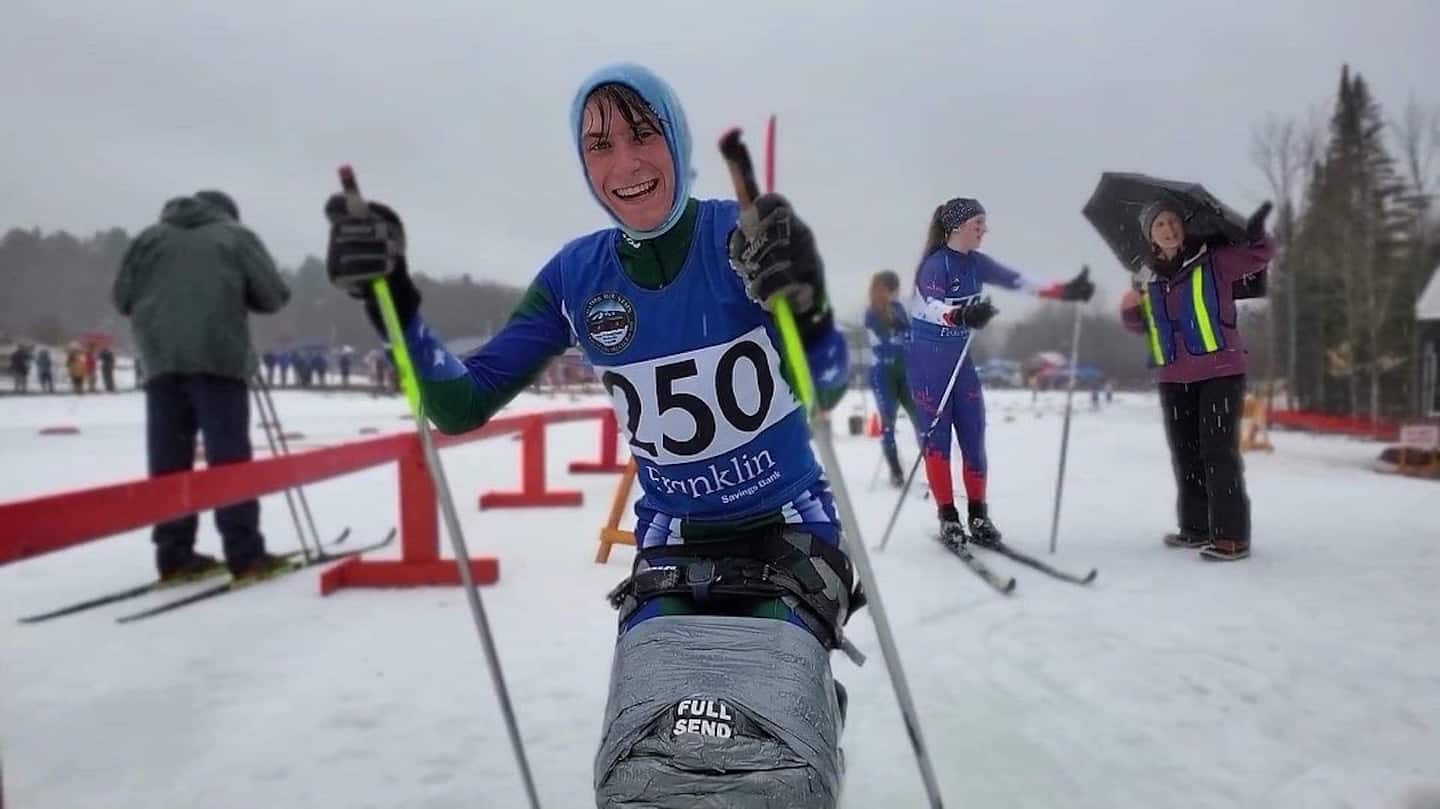
‘Oh, I’m Actually At The Right Pace’: The Sit Ski Fit Right For Dev Skier Otis Loga
by Alex Abrams

(Photo courtesy of Otis Loga)
A year ago, Otis Loga was planning to borrow a pair of skis from his high school and race with them during the cross-country skiing season.
Then, a box arrived at his home in Montpelier, Vermont.
When Loga opened the box, he found skis, ski poles and a bucket seat for him to sit in while gliding across the snow.
BethAnn Chamberlain, the national development coach for U.S. Paralympics Nordic Skiing, had sent the ski equipment to Loga, so the teenager with mild cerebral palsy could give sit skiing a try.
Loga admitted he initially hated the sit ski after he took it to his school and used it for the first time with his coach’s help.
“I did not really know how to get in it properly, so I had my feet out in front of me instead of tucked underneath,” Loga said. “So I couldn’t get up by myself, and I couldn’t go up hills by myself or do anything because I had no strength.”
Once Loga figured out how to properly sit ski, it quickly became one of his favorite sports in addition to cross-country running. He’ll compete in both sports during his upcoming senior year of high school, and he’s already making plans to devote more time to Para Nordic skiing before he starts college.
The 17-year-old Loga attended his first training camp with U.S. Paralympics Nordic Skiing last winter in Sun Valley, Idaho. It was the first time he had trained with other sit skiers after spending two seasons as a standing skier.
“I learned a lot, and it was really eye-opening to me because I could see that, instead of being the last person to the finish line every single race because I was the only sit skier … I went to the camp and I got to ski along with all the other sit skiers,” Loga said. “I could see, ‘Oh, I’m actually at the right pace and I’m actually kind of fast now compared to other sit skiers.’”
Loga was born with cerebral palsy, which affects his short-term memory and the left side of his body. He has difficulty writing and staying on his feet when he’s standing.
“Balance is an issue. Standing on one foot is like maybe five seconds maximum,” Loga said. “And then my left hand has a mind of its own and decides when it wants to shake and whack people in the face and do crazy stuff like that.”
Loga doesn’t come from a family of skiers. His father and brother go downhill skiing on occasion, but Loga has been more of a runner over the years.
Last fall, he was preparing to compete in one of his last cross-country running races of the season at the Craftsbury Outdoor Center in Craftsbury, Vermont.
Before the race, Loga’s coach noticed that U.S. Paralympics Nordic Skiing had set up a table outside a building to introduce athletes to the sport. The table had photographs for athletes to look at and a bucket seat for them to try out.
Loga’s coach told him that he wanted the teenager to stop by the table.
“So I walked up the hill and looked around and checked it out, and then I had to go for my race. It was my race time,” Loga said. “But then after the cross-country race, I went back up and I tried to sit in a bucket and put my name on the email list and said, ‘Yeah, I’ll give it a shot.’”
Loga said sit skiing sounded like fun because it meant he could ski without falling down like he often did while standing on a pair of skis. His center of gravity is lower in a sit ski, and he has more stability.
“When I (sit) ski, I can actually be in charge and kind of go where I want to go. And it’s nice,” Loga said. “I can actually ski alongside my peers and the rest of my ski team.”
Still, it took some time for Loga to get the hang of sit skiing.
While competing as a sit skier last season, Loga had a guide follow him during every race to make sure he didn’t slide backward while going up hills. Before he got a bucket seat that worked better for his body, Loga also needed the guide to help him up if he fell.
“Once I got my bucket that actually kind of fit me correctly and I had my legs tucked underneath, then it was like night and day,” Loga said. “I could get up by myself. I could get up hills by myself.”
Loga said he’s already planning to take a gap year after he graduates from high school next year to spend time on snow. He wants to live somewhere outside of Vermont where he could train with other sit skiers.
There’s more he’d like to accomplish in the sport.
“Paralympics, here I come,” Loga said, laughing.
Alex Abrams has written about Olympic sports for more than 15 years, including as a reporter for major newspapers in Florida, Arkansas and Oklahoma. He is a freelance contributor to TeamUSA.org on behalf of Red Line Editorial, Inc.